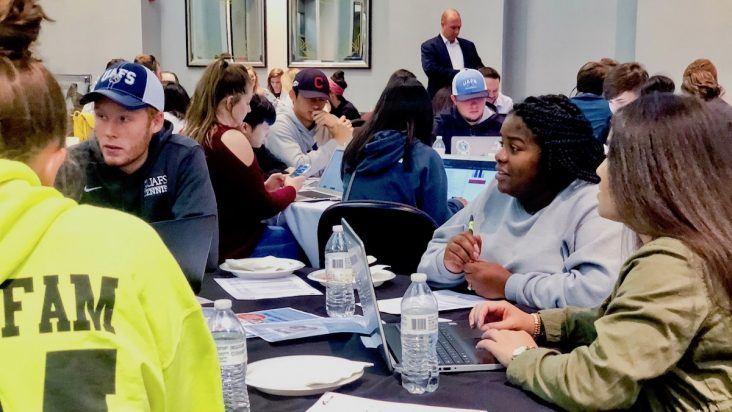Pathway to citizenship, ending wars, ideas among students at ‘Debt Fixer’ event
by October 13, 2019 12:01 pm 638 views

About 160 college and high school students gathered Friday (Oct. 11) to try their hand at a national problem that continues to plague policy makers and politicians — how to fix the national debt.
First National Bank of Fort Smith, University of Arkansas at Fort Smith, and the Washington, D.C.-based Committee for a Responsible Federal Budget (CRFB) hosted the “Debt Fixer” event held 11:30 a.m. to 1 p.m. in the Reynolds Room of the Smith-Pendergraft Campus Center on the UAFS campus. The event was open and free to all UAFS students. Members of the Fort Smith Regional Chamber of Commerce’s Junior Leadership Academy also were invited to the event; four of them attended along with the UAFS students.
The CRFB, formed in June 1981, is a non-partisan group that works to educate the public on federal budget issues. The group also works with members of Congress to provide analysis and other information on the country’s fiscal condition.
Each of the 30 student groups had a laptop to use the Debt Fixer, an online tool provided by the CRFB, to consider how to reduce the national debt. Areas the students considered include healthcare spending, education and infrastructure, defense spending, Social Security, farm bill budgets, individual income tax and other domestic spending.
Mike Murphy, CRFB chief of staff and director of strategic initiatives, said in an interview prior to the event it’s important for university students to become more aware of the debt problem. He said the goal is for student groups leaving this program and others like it CRFB holds across the country to leave with three things — knowledge, understanding and hope.
“I hope they grasp a little more education on the budget, to see the big picture. Second, they hear about the national deficit. Hopefully they will better understand why that is an important issue. And third, going through simulation they come out with a little hope, knowing it is possible to solve some of these problems,” Murphy said.
Murphy tasked the group with study and discussing options with other students at their table in order to find $4.95 billion in budget savings over the next 10 years to reduce the debt from a projected 95% of the economy in 2029 down to 79% and to identify nearly $5 trillion of deficit reduction to bring the national debt down from a projected 155% to 50% by 2050.
“There are lots of ways to fix it, which is what we are trying to illustrate. There is no perfect solution. It’s just a matter of trying to pick your priorities and make it all add up,” Murphy said.
Prior to students using the debt fixer tool, Murphy conducted a brief review of the nation’s fiscal situation. He noted that the federal government would in fiscal 2019 collect $3.5 trillion in revenue, spend $4.1 trillion and end the year with more than $23 trillion in national debt. The fiscal year 2018 deficit was around $900 billion, up from $782 billion in fiscal 2017.
“Consistently over time the government has been spending more than it takes in. We have been running significant deficits for many years. Next year, we are to hit $1 trillion in annual deficits, and those deficits are going to grow and remain permanently for as far as the eye can see,” Murphy said.
He noted approximately half of the federal budget goes to critical social programs Social Security, Medicare, and Medicaid. Along with other mandatory spending, this accounts for 61% of the federal budget.
Students then spent about 30 minutes working in groups with the online debt fixer tool. Their choices, Murphy said, were important because it gave a few of what the new generation entering the workforce felt was important.
“A nation’s budget should reflect a nation’s priorities,” he said.
Chris Towner, a CRFB senior policy analyst, reported “almost all” of the groups reached the CRFB target goals. He said as a whole the groups chose more spending cuts than increased spending. The most popular option was to provide a pathway to citizenship for undocumented immigrants, which would decrease spending by 5% in 2050. Another popular choice of all groups was to cut spending by ending the wars in Iraq and Afghanistan.
“Some that were more controversial and that came in at about 50% was raising the normal retirement age to 69 and enacting a carbon tax,” Towner said.
He also noted that almost no one chose to increase benefits to the elderly through Social Security or the specific spending cuts that come with the domestic program, choosing rather to favor general cuts.
